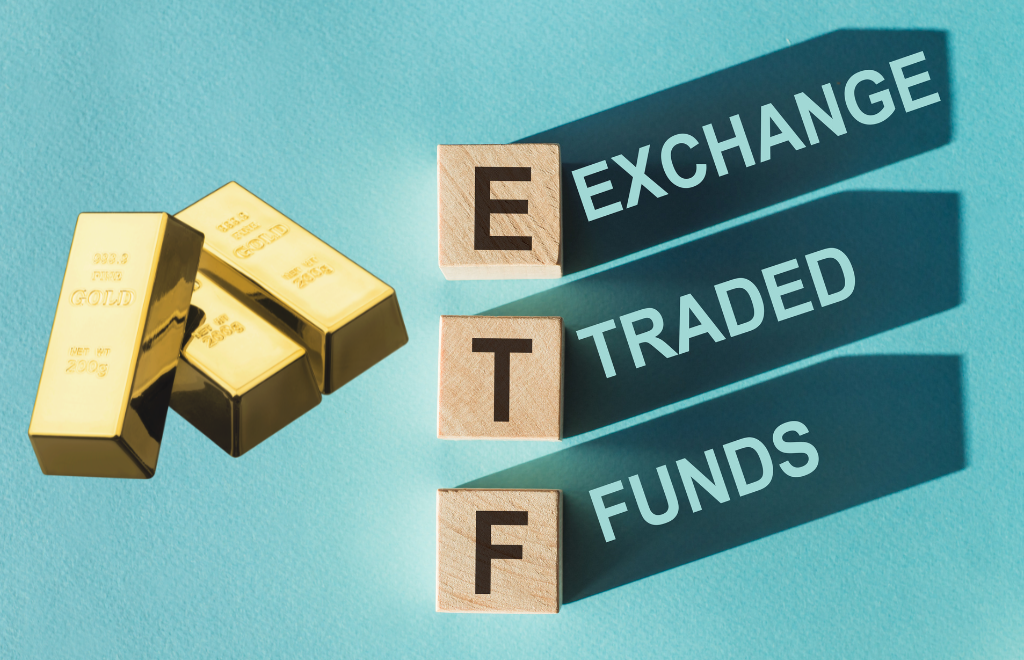Gold ETFs are similar to exchange-traded funds, in that you can buy and sell shares on the exchange. Just like an equity mutual fund, where a pool of money is raised from investors by an asset management company (AMC) to invest in shares, this is the case here, but with pure gold as the underlying asset.
The AMC allocates shares to investors, which can then be traded on the exchanges. The price of the ETF correlates with the underlying physical gold, adding the flexibility of equity investment to the age-old simple gold investment.
In essence, buying gold ETFs means buying gold in electronic form.
How Gold ETFs Work


Each unit of a gold ETF represents one gram of gold and is 99.5% pure. This physical gold is stored in the vaults of custodian banks and acts as the underlying asset from which the units derive their value.
This can be illustrated by the following example: suppose the AMC decides to assign the value of 1 gram of gold to each unit, then the price of each unit the price of gold will be about the same as the price of 1 gram of gold. There are various mutual funds that allow consumers to trade in gold ETFs. Some of them are Nippon India Gold ETF, Axis Gold ETF, Kotak Gold ETF among others.
Advantages of investing in gold ETFs
- No price fluctuations: Gold ETFs are bought and sold at the same price, which is not the case with physical gold. The physical gold market trades at different prices in different geographical locations. Also, the buying and selling rates are different to cover the liquidation and other costs involved in trading physical gold.
- Purity: While the physical gold market lacks the transparency to provide confidence in purity, when you trade in gold ETFs, purity is assured as the industry is organized and 99.5% purity is the standard.
- Liquidity: The convenience of selling the product, which is listed and traded on recognised stock exchanges, can never be matched by dealing in physical gold.
- No fear of theft: Gold stored in demat form frees the investor from the worries associated with physical gold. It also helps the investor save on vault charges that are otherwise incurred to keep the physical gold safe.
- No entry and exit charges: There is no entry or exit load on investing in gold ETFs as they are traded on the stock exchange.
- No indirect tax costs: Physical gold attracts indirect taxes like GST at the rate of 3% on the purchase and sale value. This cost is saved in ETF transactions as ETFs are securities and securities are specifically excluded from GST.
Risks of investing in gold ETFs
- Volatility risk: Gold as an investment option has historically shown exponential growth only when the economy lacks stability. The metal’s luster is inversely proportional to economic scenarios. For example, gold reached an all-time high when the world was hit by Covid-19 and is now trading at almost 20% below those highs when the economy is stabilizing.
- Time limit on trading: Exchange trading is limited to five working days between 9.15 am and 3.30 pm, making it difficult to trade the metal in the same way as physical gold, which is available year-round in shops that often sell between 9 am and 9 pm.
- Expense ratio: These are the fees charged by the AMC and added to the purchase cost to ensure the smooth running of the fund. The expense ratio includes fees for record-keeping, payments to cover staff salaries, and other general allocated expenses. These costs do not apply to physical gold and direct equity investments.
- Lack of physical delivery options: Investments of more than 1 kg of gold can be delivered physically, which reduces the product’s acceptance by the general public who compare it to physical gold, where the quantities traded can be as small as 1 gram.
- Limited trading volumes: the product being new and not very well known does not see much liquidity on the exchanges, which reduces the profits made. This can be understood by the logic of supply and demand: if the seller is in need of funds, he will eventually be willing to sell at a lower price in order to meet his needs. This happens because buyers want to buy at a lower cost, effectively reducing the profit made.
- Sentimental value: Gold demand has historically been driven by sentimental value, which gold ETFs do not justify and this reduces the product’s acceptance by the general masses.
- Taxation: Gold ETFs are taxed on sale resulting in capital gains tax, which is an additional liability to the investment. This is not the case with the other digital gold option, Sovereign Gold Bonds (redemption at maturity is tax-free for SGBs).
Ways to invest in gold ETFs
There are two ways to invest in gold ETFs: the direct route and the passive route.
Direct route: Purchasing units of gold ETFs requires opening a demat account through a stockbroker. After that, units of gold ETFs can be bought directly through the stock exchanges, just like buying shares.
Indirect route: If you don’t want to invest in gold ETFs through the demat option you can invest in gold mutual funds that invest in gold ETFs indirectly. For example, the HDFC Gold fund invests in HDFC Gold ETFs. These are called funds of funds. This option is usually preferred by investors for whom investing in mutual funds through their app is convenient or easier to understand.
Gold ETFs compared to other investment products


Gold ETFs versus physical gold
- Comparing gold ETFs to physical gold is not entirely justified, as physical gold is used for jewelry as well as investment.
- Physical gold investments have different buying and selling rates, which is not the case with gold ETFs. However, the benefits of the traditional use of the commodity have historically outweighed the benefits of the digital product.
- When comparing investment ratios, indirect taxes, differences in buying and selling rates, as well as safety and liquidity, must be considered.
- A detailed understanding of return requirements and investment purpose is required before investing in either option.
Gold ETFs vs. SGBs
- Sovereign Gold Bonds (SGBs) are a product sold by the Reserve Bank of India (RBI). It is sold through a series of closed-end opportunities that are offered throughout the year. The product offers 2.5% interest on the actual value of the investment, in addition to the gold appreciation of the commodity. Put simply, SGBs help investors put their idle gold to work for them.
- Unlike gold ETFs, this product has low trading volumes, which is detrimental to investors’ interests.
- Both products serve as an alternative to the traditional method of investing in yellow metal. SGBs are backed by the RBI, which increases confidence in the product. Gold ETFs on the other hand, have higher trading volumes than SGBs.
- Investing in either of these products requires careful consideration of the average holding period that the investor wants to opt for.
- Other digital options, such as Paytm Gold, offer the physical delivery option that small gold ETF investments lack.
Gold ETFs vs. equity investments
- Long-term equity investments in quality stocks have provided good returns to investors and the liquidity and fair pricing of equity investments have been able to attract investors. This is similar to gold ETFs, which offer investors the same convenience of liquidity and fair pricing. The two options are therefore complementary rather than comparative.
- If you were to choose one over the other, you would need to consider risk, overall stability over the investment horizon, economic growth prospects in the specific investment sector, and geography.
Gold ETFs vs. debt investment
- Debt investments provide an investor with the comfort of a promised return unless the economic health of the investment deteriorates. The debt market therefore ranks bonds to indicate the quality of the underlying asset class.
- Bond prices, which fell sharply during the recent pandemic, have now begun to stabilize, bringing bond yields down. Thus, just like equities, bonds react negatively to bad economic scenarios, giving gold the opportunity to hedge the position.
Bottom line
Investors who are comfortable with the idea of digital options should understand the liquidity risk, and time horizon requirements and analysis the pros and cons before investing in gold ETFs. The key point is to have a diversified portfolio, and achieving this by investing in gold can prove to be a good choice if done with in-depth research and understanding.

